In our continuing invisible effects series, we go behind the scenes of the crowds in Here Comes the Boom, the creation of Tehran locations for Argo, enhancements for Alex Cross and the stunning casino strip in the new TV show Vegas. UPDATED with before and after images from Here Comes the Boom.
Vegas – Encore VFX
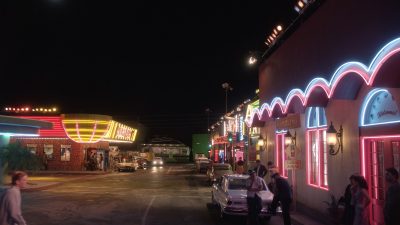
The new CBS TV series Vegas is already building a healthy audience, not only because of the show’s slick telling of the rivalry between an old-school Nevada sheriff (Dennis Quaid) and a Chicago mobster (Michael Chiklis) intent on growing his casino empire, but also from its retro 1960s palette. Helping to flesh out the ‘Old Vegas’ in the series is Encore VFX. We talk to Encore’s creative director and visual effects supervisor Stephan Fleet about virtual backlots, Lidar scans, neon signs and how to avoid unwanted car window reflections.
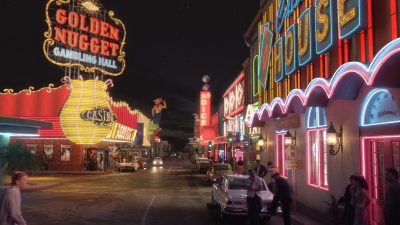
Vegas plays out on the famous Fremont Street and in the Nevada surrounds. In order to re-create the evolving Las Vegas casino strip, the show is filmed on an elaborately constructed backlot at Santa Clarita Studios, northwest of Hollywood. “They actually built a eight-building long strip of Fremont Street,” explains Fleet. “They took a piece of their parking lot and literally created that. But they only created it one or two stories high, so when you look down either direction you see sound stages and other things.”
So, for the series, Encore is digitally extending the Fremont Street views in both directions and adding extra stories to the 30 to 40 buildings in each shot. Large greensceens are employed, but Fleet notes that the production has cleverly built the backlot to connect to an actual sound stage for the show’s central casino, the Savoy. “They painted the facade and put an awning on the sound stage to look like the first floor of their casino,” he says. “So when you enter the sound stage it looks like a casino, you can go inside and outside of the location. The challenge was that they only built the first two floors of the casino and we needed to make it a seven storey building, including the sign that says ‘Savoy’.”
Encore’s visual effects work for Fremont Street relies on photographic reference, HDRs and a Lidar scan of the backlot. “We didn’t aim for too high a resolution scan,” says Fleet. “Those are great for architectural purposes but when you’re trying to go very quickly in visual effects, our 3D lead suggested we go for scale and shape and then we re-modeled and re-topologized everything.”
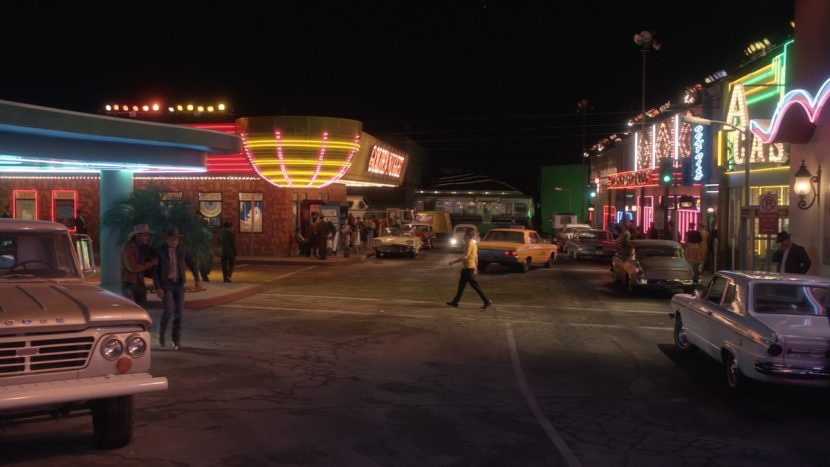
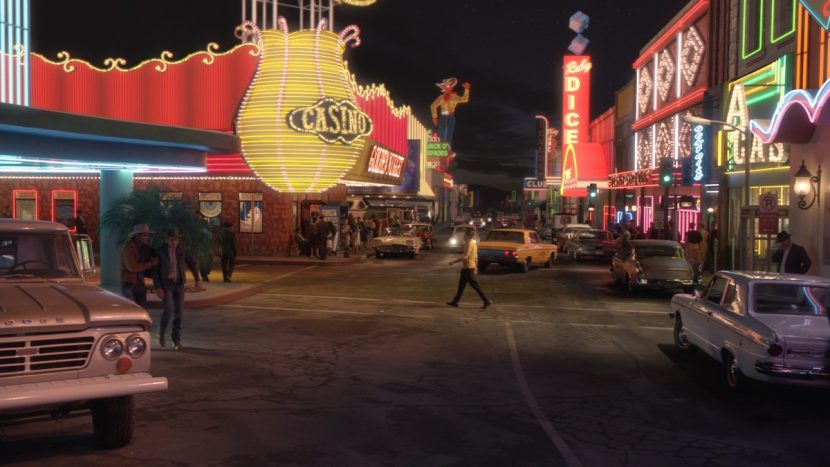
Artists use 3ds Max for modeling the buildings, utilizing a script that allows them to take a 3D track in SynthEyes of the original plate and the models and ‘snap’ them into a representation of the city. “It means if the production wants to do a wide shot or pull-out or aerial shot, we now have the functionality to put the whole city there,” says Fleet.
An important part of the visual effects work involves matching to the production design and to what Fleet calls a ‘faded eroded texture’ seen in the show, which is being filmed on the ARRI Alexa with ‘classic glass’. “The creators wanted to show that this is a booming city but that there’s an element of corruption at the same time,” notes Fleet. “We dialed in a look to the signs and the buildings so that they aren’t all just pretty. What we’ve also done is mapped a lot of lenses and shot a lot of classic glass grids, then made really detailed focal length plug-ins for Nuke so that we can match the look.”
Of course, Las Vegas would not be Las Vegas without neon lights – a feature of the buildings and signs also enhanced by Encore. “We’ve spent a lot of time studying the properties of neon in day and night,” comments Fleet. “Because they built the practical set with a heap of neon, we were able to go there and do a lot of surveying with cameras and macro lenses to take photos and video of how neon reacts in reality.”
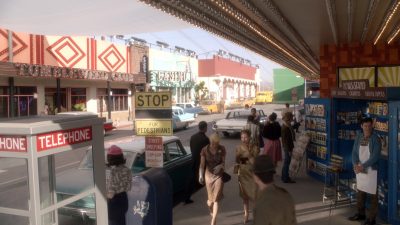
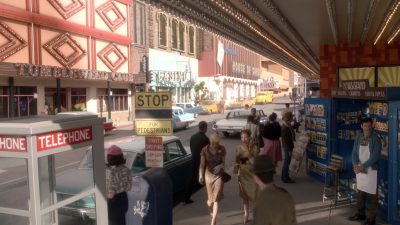
“Actually,” adds Fleet, “if you start looking closely at neon tubes there are a lot of imperfections in the glass. It’s particularly challenging to make that work in daytime – because neon’s really made for night. You have the extra challenge of sun bouncing off the glass, so how much specular highlighting do you put in? How much power does the neon have to have to overcome the sun? The reality is that after shooting macro shots of all the neon there, it’s different for each type of neon used, the different colors, placements and angles.”
Along with the buildings, Encore’s effects work extends to animated digital traffic. “Cars have always been a challenge,” admits Fleet. “They’re like big bendy mirrors – you can get a lot of crew reflected in them and green spill and unwanted reflections. We have a special rig we use to shoot our driving plates where we get a semi-spherical reflection plate. It’s pretty warped footage already and you take that and grid warp it and cheat it over the curves of the car.”
In one particularly challenging sequence for Encore, a character is seen walking down an aisle of vehicles. The scene was shot with real cars in front of a large greenscreen, with artists required to insert a new background. But during filming Fleet noticed several unwanted reflections in the car windows. “I had to ask them to roll down the windows for the shoot and so we have to add them back in. We took all the set measurements and then tracked the shot by putting CG models of our cars on top of the real cars to get the windows in the right place. Then we use spherical HDRs of the set to reflect whatever we need to in the windows.”
A library of extras shot on greenscreen and digital doubles are also relied on to fill out the street scenes, some even created with an ingenious low-tech motion capture technique. “Our 3D lead Mitch Gates built his own little mo-cap studio in his house using a Kinect system,” says Fleet. “Every now and then he’ll say, ‘Hey, I have to go to my mo-cap studio,’ and he’ll do some actions there and come back with the mo-cap data. We have all these stock people and we clothe them for the period. It works great!”
Encore’s turnaround times for each episode of Vegas have, for the most part, been around two weeks, with a three-episode cycle of shooting, prep and final visual effects work always in motion. Fleet says that on this show the effects are clearly just one part of the storytelling tools, and used to complement the incredible work achieved in-camera. “What I’ve been doing in visual effects is to find ways to shoot and adapt our workflow to how we shoot,” he says. “I’ve really worked hard to try and let us use the tools at our disposal to make shots possible.”
Alex Cross – Look Effects
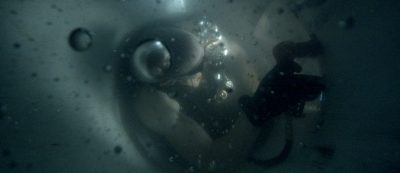
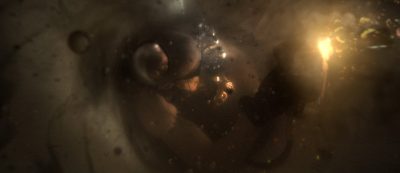
Director Rob Cohen is no stranger to visual effects films – he previously helmed The Fast and the Furious, xXx, Stealth and The Mummy: Tomb of the Dragon Emperor. But his latest pic, Alex Cross, called for effects of the invisible variety. That work fell to Look Effects, who fleshed out 125 shots involving matte paintings, set extensions, explosion augmentations and even missing fingers.
Telling the story of Dr. Alex Cross (Tyler Perry) facing off against serial killer Picasso (Matthew Fox), the film is based on the character in the novels by James Patterson (Cross was previously played by Morgan Freeman in Kiss the Girls (1997) and Along Came a Spider (2001). Look Effects’ role was, according to visual effects supervisor Derek Bird, to assist editorial in enhancing certain scenes, although it did have a number of significant sequences.
In one scene, Picasso is submerged in a pipe and cuts himself free with a torch. Production filmed a small pipe and its encasing extending up 25 feet, with Look extending the camera view with a 3D pipe completed in Maya and Nuke based on the set reference. Artists also added 3D bubbles and dealt with the cutting torch. “The director wanted some smoke coming off it,” says Bird, “which underwater looks like a liquid coming off the torch. To get that we actually shot paint through a tube in a clear tank and squirted it through the tube. So we had a liquidy asset and we color corrected it and added it to the shots. Actually, throughout the whole show we were trying to come up with some clever approaches to use 2D assets as well as 3D.”
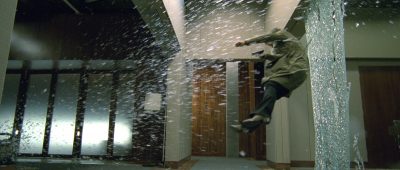
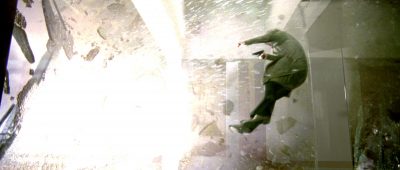
Another significant sequence was the Detroit courthouse bombing, in which Picasso fires a deadly rocket propelled grenade. On location – in Cleveland – production set up a practical explosion that wrapped around foreground SUVs and rigged vehicles to react to the blast. Look then created a particle system for the initial green gas explosion, blending it into the practical flames which were augmented since they had been set off as a series of adjacent charges. Additional work was required for backgrounds, the RPG itself and for clean up of the car catapult and wires, as well as to enhance the reaction to the explosion.
“When the explosion knocks the guys backwards, the actors were great in terms of running full steam ahead and getting jerked back, but there was something just missing,” says Bird. “So we added a little distortion with a lighting effect to kind of make it look like there was a force knocking them back.”
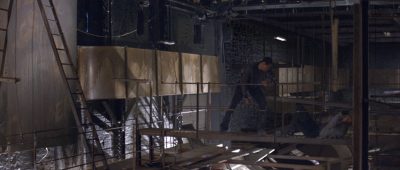
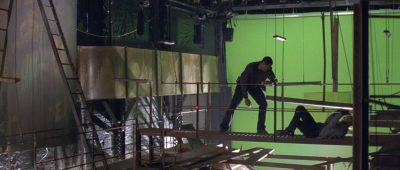
The film’s climax takes place in the attic of the Michigan Theater in Detroit, where Cross and Picasso engage in a fistfight. The real attic was too dangerous to film the sequence so it was mostly shot on a soundstage. “They knew they’d have to put a greenscreen in to extend it out and give the scene some depth,” says Bird. “They built a section of the set dressed to simulate the real location. We used the real space as a guideline but we took over what was actually shot in the plate.”
Look also contributed several other wire removals, muzzle flash additions and even glass enhancement. “There’s a shot of one character crashing through a glass wall,” notes Bird. “The glass she crashes through actually broke before she hit it, so we had to fix that plate with the timing and we used some 3D glass for her to break through, and then we used the same asset to add more glass to the tail of the shot, and added more smoke to tie it altogether.”
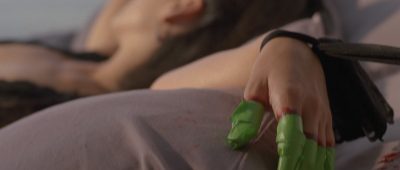
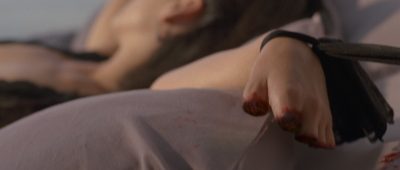
A car crash ‘t-bone’ scene also relied on some Look Effects ingenuity. “The director wanted to start with the camera in the back seat and then move to the front seat in one shot and reveal the car crashing,” outlines Bird. “We had to blend two plates together – one shot on set and the other shot on a greenscreen stage. The timing never quite works out so we had to extend the car on the greenscreen and rock it back and forth, with the camera moving around and everything, to get the timing right.”
For a shot depicting one of the character’s fingers having been cut off, Look removed the real fingers from the original plate and added severed ends using quite a unique reference. “We actually cut off the end of a chicken leg and seared it, which gave us the severed tip part,” explains Bird. “So when we actually did the shot we used the reference photos and composited that into the shots. We did some improvising to come up with something on the fly without it having to be done in 3D, which was really indicative of the show.”
Argo – Method Studios
Ben Affleck’s spy thriller Argo, based on the true story of the exfiltration of six US embassy workers from Tehran at the end of the 70s via a risky Hollywood ruse, brought it with several visual effects challenges. One, of course, was the period setting, and another was the non-existent access to Iran to reference buildings and sites featured in key scenes. Despite these obstacles, Method Studios was able to realize numerous important visual effects shots for the film.
“We had to build the Azadi Tower with CG traffic and people as we couldn’t go to Tehran to shoot a plate,” recounts Method Studios LA visual effects supervisor Matt Dessero. “We had to build airplanes at Tehran airport as they’re leaving the airport. And we had shots around the US Embassy and the Sheraton Hotel. There were Tehran views with mountains in the background. There’s also a some burning flag effects in front of the embassy, and some smoking grenade gas bombs.”
Views of the Azadi Tower, a soaring archway marking the center of Tehran, were completely digital, and also showed the chaotic surrounds of the capital in a time just after the Iranian Revolution. “The only thing really that we had at our disposal was Google Maps,” says Method CG supervisor Michael Sean Foley, “and that’s exactly how we started with a top down satellite photo of the Tower. “Then we used all the other pictures we could glean off the web. Half-way through, once we had a photo-real model, the director wanted to compress the set a little, and make the city feel a little more congested, so it’s not an absolutely real representation of the location, but it was a story point to make it more confined.”
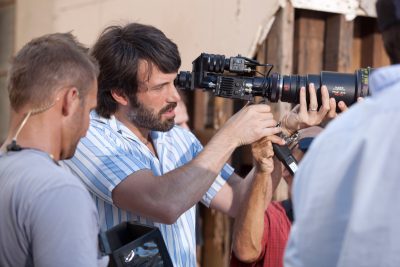
Crowds and cars were added using Massive (with Method Vancouver handling people and Method Sydney dealing with vehicles). The tower and surrounding buildings were modeled and textured in Maya and rendered in V-Ray, with cars and people rendered using RenderMan. Nuke was the compositing platform. “There’s a lot of layering that goes into the shots,” says Method compositing supervisor Alex Gitler. “There was matte painting in the background, stacks and stacks of different layers of haze, smoke, lens flares and lens aberration effects.”
“We went for a very white sky, blown out which gave us the opportunity to put a white haze over the city,” adds Dessero. “We played the grain up and make it feel very 70s. We added a little hand-held camera movement, more than we normally would, because we would usually mimic float based on Spacecams or Wescam mounts, but we bounced it a little more to set the mood.”
Extra details included the addition of trees, leaves, antennas and banners on buildings and long raking shadows. “What really sold the shot was having sun glints on top of the building as the camera pans around,” notes Dessero. “And even for the traffic, we started out with five generations on the cars but ended up with close to 20 with dented cars and textures. The buses even have smoke coming out of them.”
Argo opens with student demonstrations outside the US Embassy in Tehran, where protestors burn the American flag and then storm the building. Here, Method added flame effects, the vast crowds and shots of the compound with digital buildings. These were modeled in 3D, but close-in views were filmed at the VA hospital in Burbank. Iconic photographs of the siege provided crucial reference for Method’s artists (a fact highlighted by the film’s pre-end credits sequence which shows the real vs. movie scenes).
See more of Method’s vfx shots in this Argo featurette.Again, Massive was relied upon for CG crowds and extra trees, atmosphere and further details added in. “One of the cool challenges we had,” says Foley, “was that they wanted to show that the Embassy was under siege and everybody was in the building. Once we did that, it became too sparse and we had to find other tricks to show the detail in the building. So we came up with leaves blowing across the ground.”
In a tense finale, the six US workers are taken to Tehran airport and attempt to leave under cover of a Canadian film scout group, making their escape to Zurich despite a runway chase by the Iranian Revolutionary Guard. Method provided a CG airplane and mountainous Tehran backgrounds for the sequence. “They shot the plates at LA/Ontario Airport in California,” says Dessero, “and we had to replace the background with the Tehran cityscape and mountains.”
The plane, seen taxiing on the runway, was added to the plates of police cars giving chase. “We originally talked about the shots only being a close-up of the nose of the plane,” says Foley. “We started with a model of a DC-10, and modeled that as a very hi-res model. Then they decided to go for a 747, so we turned it around and did the exact same thing for the 747. And then everybody loved our first test, so the director broadened the shots and we built the a whole 747-S from circa-1979.”
“The biggest challenge for the plane,” adds Foley, “was to make it heavy, to make it look like it was really traveling. We had the speed of the chase cars factored into it, although we had to speed up the plates for some shots. The textures helped keep the element of scale of correct and all our panels and rivets were specifically designed to match the scale of the plane.”
Here Comes the Boom – Zero VFX
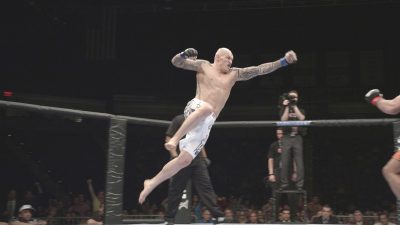
A common problem in making fight movies – think Rocky, Raging Bull, even Real Steel – is how to stage an arena bout with real atmosphere. It’s expensive to have hundreds let alone thousands of extras on set while choreographing a fight sequence. In the past, filmmakers have tended to use tricks such as spectators sitting in just the first two rows with the remaining background fading to black and relying on cutaways for crowd shots. More recently, computer generated crowds have been employed to spectacular effect, although mostly for wide shots.
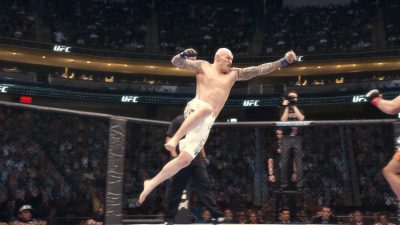
But on Here Comes the Boom, in which an unlikely biology teacher Scott Voss (Kevin James) turns UFC fighter, director Frank Coraci wanted to ensure the movie’s key fight sequence in front of 18,000 people at the MGM Grand looked real, even though it was a shot at multiple locations and with only 300 extras.
The task of creating a believable crowd for the UFC fight between Voss and his opponent fell to overall visual effects supervisor Pete Travers, who enlisted Zero VFX to complete 225 shots on the film. Here’s how Travers and Zero’s visual effects supervisor, Sean Devereaux, approached the crowd by filming at an actual UFC fight, shooting the fighters separately at a different stadium, acquiring crowd tiles, and combined all these elements for the final shots.
Filming a real fight
There were two kinds of shots of the fight the filmmakers required – wide establishing shots and then shots where the live action camera is inside the ring, or more correctly, the octagon, a crucial element in lining up the locations down the track. Travers’ strategy was to shoot at a real fight (where time and access would be challenging), match those shots in a more controllable setting and then make the final shots appear to be at the MGM Grand.
“Inside the ring was about 75% of the shots,” says Travers, “with an arbitrary camera, the two guys rolling around punching. We didn’t know what footage we’d end up with. So it was my call that we shot at an actual event before we choreographed the fight. The problem to solve was: we didn’t know what we were going to get and we needed to make sure – because we were going to be using two-and-a-half-D techniques – that the cameras we were using in the arena could be mimicked.”
The real fight was filmed at a UFC event at the Prudential Center in Newark, New Jersey. Here, a relatively small film unit of ten people including the director, DOP Phil Méheux, Travers and camera operators captured the action with Sony F-35s. “The one stipulation from the UFC was that we could only be down on the ground floor near the octagon during one of the fights and it had to be one of the ones before the main card,” recalls Travers. “We decided to do the last of those fights because we knew the crowd would be filling in as time went on.”
Next to the octagon, the crew shot 180 degrees around the event, three tiles across, with an F-35. Later, when the title card fights were in full swing, four cameras were used to shoot multiple angles around the arena. “When we shot at the event we learned that there are a tremendous amount of lighting conditions that happen during the course of fight night,” notes Travers. “The UFC really deck out the lighting changes during the course of a fight, so we had to match that timing. And when we needed to have a wide shot of the crowd celebrating we had to make sure we were in the right position for the last fight, and that the majority of the crowd was actually rooting for the guy who eventually won!”
Filming a fighting Kevin James
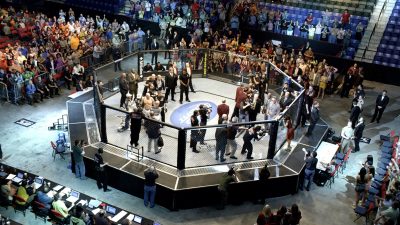
The fight sequence itself with Voss was filmed in a smaller arena – the Tsongas Center at the University of Massachusetts Lowell. Travers reasoned that as the Prudential and Tsongas Centers both had hockey rinks as their floor base, and both had a standardized octagon in the center, that lining up and matching shots would be made easier.
Shooting took place over 10 days, with a middle weekend used to film crowd tiles of 18-25 takes with 300 extras for 15 sections of the arena. “We took the octagon out of the center,” explains Travers, “moved it off to the side, placed a camera in the middle, put some crowd in section one, had them go through all the actions we needed them to do, then moved them around, spread them out, changed their shirts, and then repeated for section two, and the rest of the arena.”
One particular challenge considered while shooting was the ubiquitous UFC chain link fence around the octagon. “We had to work out how we were going to place crowds through the fence,” says Travers. “So we came up with the idea that when we were seeing through the fence at the crowd past Kevin, we would take out the chain links. And Zero replaced it in 3D. It got tricky when Kevin literally had to make contact with the fence – quite a lot of the time.”
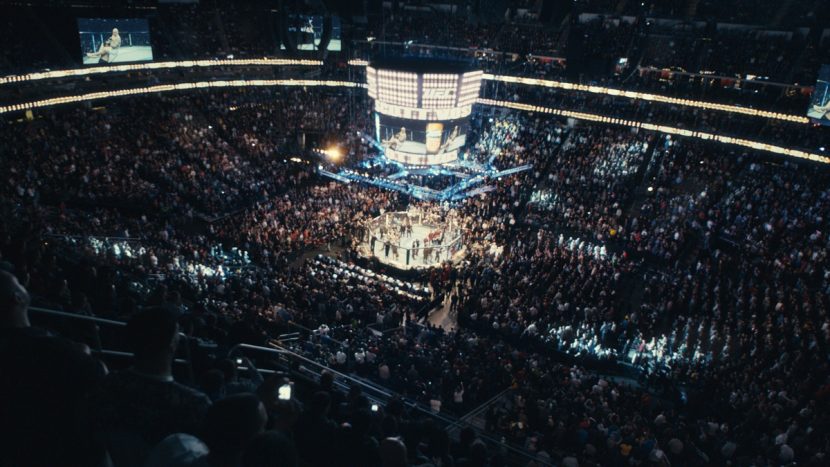
Zero’s crowd approach
Armed with plates of the stand-in Prudential Center, the actors in the Tsongas Center and the crowd tiles, Zero VFX set about creating a system to re-create the sequence as a UFC fight at the MGM Grand. That required several things – a crowd solution, a CG build for the final arena and also the incorporation of the fighters into stadium screens.
Crowds
With so many takes of the crowd tiles from the Tsongas Center, Zero had massive amounts of data and needed an efficient solution for tinkering with the crowd to match the film’s edit. “So we spent the first three months of the show building automated gizmos in Nuke that allowed us to literally move the crowd with a slider,” says Devereaux. “That meant we could say, ‘Now the crowd is screaming,’ and we could tweak it by one frame or 500 frames. Editorial could say to us, ‘The crowd is not excited enough’ and we could very quickly move the slider or change the lighting.”
Zero developed the crowd for the first tier of the arena in this way, while the upper tiers relied on projected cards. “It took time to roto each card which had 700 people doing different things at different times,” admits Devereaux. “It was time consuming but it was clear it would work. With the first tier, we only had 15 different angles of them and in some cases we were able to project them onto a card that was angled at the same slope as the stadium. Other times, depending on the camera move, we had to project them on a flat card that was running parallel to the stadium and not sloped at all.”
“Also,” says Devereaux, “we were told that UFC’s lights cycled which we thought would let us loop the plates. That was completely untrue, unfortunately, so although we had our crowds in the right lighting scenario, the lights didn’t move across each other and these lights – they move across everything.”
Stadium build
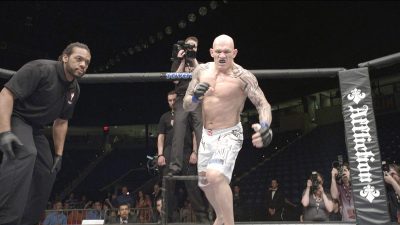
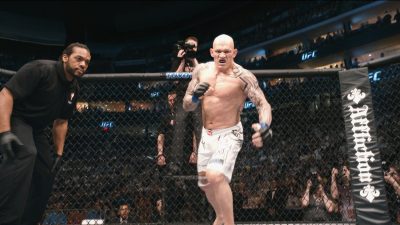
The MGM Grand was crafted in Maya (which was also used for the card placement) by combining builds of the stadiums the production had filmed. “We modeled both stadiums in high detail,” says Devereaux, “and then bent the two models together so that the tiers matched – it was a matter of morphing them into place. That meant we could put our people anywhere in the stadium.”
Zero used SynthEyes for tracking, Silhouette for roto (aided by Studio8fx) and Zync’s cloud solution for rendering. They also had to match footage sourced from different cameras and formats shot on the F-35, Red EPIC, GoPro and ARRI Alexa. But Devereaux says the biggest challenge for the stadium was re-creating the ‘black foggy’ area seen towards the roof. “We looked at what Peter shot at the Prudential Center and he had a couple of great tiles pointing straight up at the corner. It was great reference and we could use that foggy black area to put in the entire upper area of our stadium. It really tied everything together.”
Screens
Other crucial shots designed to sell the reality of the fight involved seeing images of the opponents on screens around the stadium. “One of my favorite shots,” says Travers, “is a POV from Kevin, he’s sitting down between two rounds and he’s looking up at Niko (Bas Rutten). We could have easily in the movie just had blackness behind him, but the arena stuff was looking so good that we started placing the video views behind him – it was an exceptional example of adding to the richness of the entire scene, and not just adding a few shots here and there.”
One of the advantages the effects team had for these shots was the presence of cameramen at a UFC fight. “There are actual cameramen sitting on almost every other panel of the octagon,” describes Travers. “We actually had people doing that and we were running those cameras, and the footage was used where, say, you’re watching Kevin fight but while you’re looking at the fight you see the screens in the distance – they had to look like video cameras acquired the shots. So when editorial had done their edit, we would sync up the ‘witness’ cameras and Zero put those views into the monitors.”
Extra effects
In addition to its crowd work, Zero also contributed around 30 ‘punch extensions’ for the fight, adding connection points to the choreographed bout. Some further shots were handled by Sony Pictures Imageworks India and Unchartered Territory to bring the shot count above 400. Travers notes that in all of these shots, including Zero’s crowd work, the crucial factor was not even knowing visual effects were involved. “The director wanted to make sure it looked like it was the real event. “If we put a CG crowd in without having shot a real crowd, we would not have known how to do a CG crowd. If you look at a thousand people, everyone has a little story in every shot. When somebody wins in a fight, not everybody jumps for joy. Even in the greatest fights of all time, there’s still somebody walking up to the concession stand to get a hot dog.”

Superb insight..